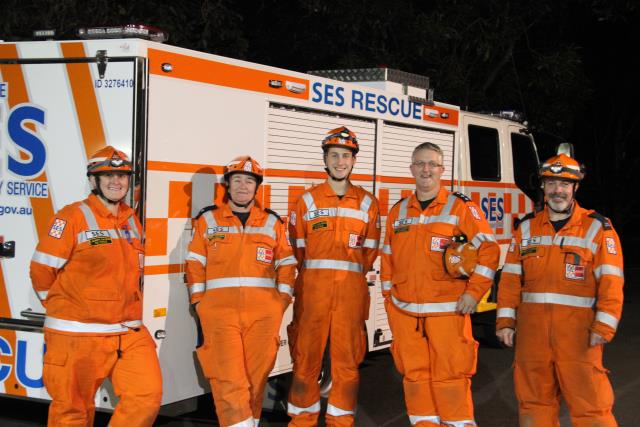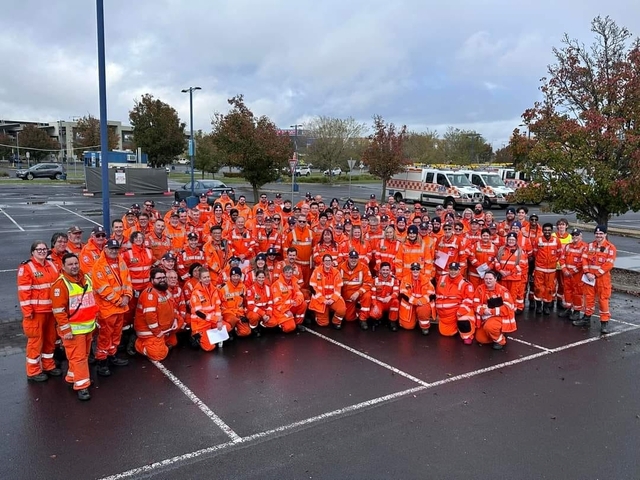
By Mikayla van Loon
Decades of underfunding for Victoria’s State Emergency Service has come to a head with a volunteer-led campaign urging for a revised but sustainable funding model.
The Fund VICSES campaign saw a group from Lilydale’s unit take part in the campaign launch on Monday 20 May with an awareness convoy flooding the Bolte Bridge.
Lilydale SES unit controller Shaun Caulfield said this was something that had been “brewing for decades” across “successive governments” on both sides of the political spectrum.
“Relative to the number of resources and the risks and the amount of jobs we do, SES has been drastically underfunded pretty much since its inception in 1975,” he said.
SES units were originally funded by local government, with one unit per municipality, bar the case of the Yarra Ranges, which has the three units plus additional support from Emerald SES.
Mr Caulfield said 10 years ago the funding model changed to an in-kind arrangement where local governments would give an annual amount which would be matched by the State Government.
“We’re talking $5,000. At one point, that did eventually go up to just over $10,000 before that scheme was wound up.
“So if your local government gave you $10,000, you got $10,000 from the State Government and all the other money we needed was by fundraising. Some units had the power and petrol and water bills and all of those things paid for by the local government, and others did not.”
At Lilydale, Mr Caulfield said at the time, the unit was receiving around $27,000 per year but had to self-fund all of the bills including the “$4,000 a year for insurance on our vehicles [and] all our fuel bills”.
“We’re in the same boat now. We get our annual unit subsidy and then we have to buy everything other than PPE.
“So we pay for our insurance bill, obviously it’s up, our fuel bill is up and the more jobs we do, the more fuel we use. So that all compounds.”
The key component to the Fund VICSES campaign is changing the structure of the current levies that bring in funds for the State Government to distribute to its services.
Currently, ratepayers pay a fire service levy as part of their rates each year, which then provides the government with a budget to support both the Country Fire Authority and Fire Rescue Victoria.
“Victoria is the only state that does not have either a combined emergency services levy that also funds SES as well as fire services, or a separate levy for the fire services and another levy that also covers the SES. So there is no sustainable funding model for SES in Victoria,” Mr Caulfield said.
Not wanting to take “slice off their pie” from the CFA or FRV, Mr Caulfield said if the government introduced an emergency services levy it would increase a ratepayers yearly fee by an average of $30.
But the difference would be extraordinary for an essential service like the SES to ensure buildings and vehicles could be upgraded or maintained.
“There is no amount of money in the budget for SES to build new buildings or to buy new vehicles that are recurring every year.
“So whilst SES is able to buy new vehicles, or build new buildings, it is because the government has said here is the money to build that [particular] building.”
Mr Caulfield said as an example, Lilydale SES will take delivery of a new vehicle later this year but in order to get it, the unit had to apply for a grant and share half the cost.
“The new vehicle that is about to be delivered to us is partly grant funded, which is not guaranteed. So we have to put in the application that is judged on merit, versus everybody else that’s looking for grant money, and be deemed worthy of getting the funds.
“But we’re still looking at around $120,000 of community money that we need to find to pay for what is called our share of that vehicle and that happens by us doing fundraising.
“So rather than being out on the tools and holding chainsaws and holding rescue equipment and doing those roles, we’re out actively doing fundraising.”
While Lilydale’s unit, by all comparison, is fairly well off because of the populated and supportive community it resides in, Mr Caulfield said some units in more rural parts of the state don’t even have facilities with toilets because “they just don’t have the fundraising capacity”.
“That makes it very hard to recruit and retain volunteers in the community when the facilities are just not up to standard.”
On a broader level, Mr Caulfield said as a “more even gender balance amongst our memberships” occurs even newer buildings, like Lilydale’s, don’t provide designated change rooms for male, female and unisex.
As a majority volunteer organisation, with only 200 paid staff, and although Mr Caulfield said there wasn’t a push for more paid positions, a government review from the last financial year found that volunteers saved the government around half a billion dollars in employee costs.
“What we want is a budget that allows us to have the equipment and facilities to deliver the service. There’s certainly no push for us to be paid for what we do.
“We’re proud to volunteer and wear it as a badge of honour, but it doesn’t make us any less proficient in what we do.”
Mr Caulfield said SES units across the state don’t need a quick fix and would be expecting this to roll over to the next budget or state election.
“We’re actively petitioning MPs at the moment of all parties and independents, to let them know where we’re at. Ultimately, we’re not we’re not expecting a handout. We’re looking at something that would give us a level of funding security.”
Despite usually asking the community to support their SES via fundraising, Mr Caulfield said instead the unit asks that people pick up the phone or send an email to their MP calling for a sustainable funding future.
To find out more, go to fundvicses.org







